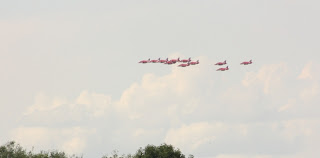Birds in Northumbria
31st July.
Well another month ends having provided some very nice highlights (often
in the sun) including my only lifer of the year so far, the Bridled Tern on the Farne Islands, a great day a Smardale
surrounded by butterflies, probably my best ever Nightjar experience and great evenings at Holywell watching waders
and the juvenile Marsh Harrier.
During the past couple of days I’ve been sorting out
literature that I have collected over the years from the Natural History
Society of Northumbria and I came across an annual report, Birds in Northumbria
1978. I must have been sent that by the
society I think, as I had no link to the bird club until recent years. It was interesting to note the names of
contributors, several who are still around, although a little more mature! Even more interesting, was to compare some of
the comments about species and try and balance the losses and gains. I’ve noted down some of the comments and
sightings below;
Little Egret. An extremely rare visitor. It was seen at Holywell on 6th May
and was only the third record for Northumberland.
Whooper Swan. 90 were at Holywell on 1st January
and this declined to 18 by 1st April.
Goosander. None reported at Killingworth Lake. (A regular wintering spot now for a number of
years)
Red Kite. A rare visitor. One seen at Woolsingham 0n 4th March
and a second bird was at Holywell for three days and then seen at Gosforth Park from 17th December. These were 6th and 7th records
for the county.
Common Buzzard. A rare breeder and uncommon visitor. A handful of sightings of single birds. (I do still occasionally come across folk who
are shocked to find Common Buzzards in the east).
Osprey. A rare visitor.
Purple Sandpiper.
Populations of 150-200 and 250-350 early and late in the year.
Mediterranean Gull. A rare visitor. Records of single birds only.
Roseate Tern. 17 pairs nested on the Farnes and 29 pairs on
Coquet Island.
Nightjar. A rare summer visitor which breeds
irregularly
Hawfinch. A rare resident breeding species and passage
visitor. Never the less up to 6 reported in Jesmond Dene. Other
breeding season reports from Stocksfield, Morpeth, Corbridge, Hulne Park,
Plessey Woods and Meldon. Winter reports
included 10 at Stocksfield on 30th March and 20 on 11th October. Birds were present in Kielder where a
juvenile was taken by a Sparrowhawk and 2 were seen on Holy
Island on 6th and 7th May during passage.
Snow Bunting. A well represented passage and winter
visitor. Reports included 150 at
Hauxley/Druridge, up to 50 at Chevington, 50 at Derwent reservoir, and three
flocks of up to 20 were at other coastal sites.
30 were at Killingworth 13th and 15th December!
Corn Bunting. A well represented resident breeder. The decline in this species was noted, but 30
were reported at Chevington Burn, 21 at Amble and 15 at Druridge.
I’m sure I can pick out many more interesting points,
especially amongst the warblers, but I won’t bore you anymore. I’m passing on my report and several others
to someone I know will look after it and find it interesting.
I checked out the lake again today. The traffic was being held up the whole time
I was down there because of Mute Swans
crossing the road in Mute Swan time i.e.
their own time. Most drivers if not
all, seem to take this with a smile.:-) I
counted 116 Canada Geese and
probably missed a few. I suspect a few
local inhabitants will not be pleased as I note that the geese do not
understand that they are meant to keep off the grass! :-) Several Common
Terns were active and the lone Goosander
remains.












































